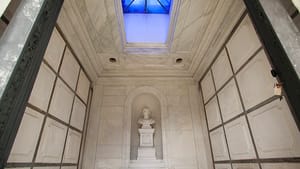Stay in the Loop
BSR publishes on a weekly schedule, with an email newsletter every Wednesday and Thursday morning. There’s no paywall, and subscribing is always free.
Culture, alive and well in the cemetery
Discovering the Woodlands in University City

Where to go in late summer when life seems too quiet? Consider a graveyard, such as the Woodlands. Really. Broad Street Review subscribers likely know that, increasingly, cultural events are happening in cemeteries, which afford natural settings, open ground, outdoor sculpture, and history as expressed through “notable residents,” as the Woodlands calls those interred in its 54 acres.
The idea of going to a cemetery for any but the obvious reason might take getting used to, but it isn’t new. The Victorians often made excursions to them. They even brought picnics. So maybe taking in a movie or attending a circus performance isn’t all that strange. But even without a special event, historic cemeteries are worth visiting.
Set just beyond West Philadelphia’s complex of “eds and meds,” the Woodlands predates its neighborhood. When the cemetery was established in 1840, the area was known as Blockley Township; it would not be incorporated into the City of Philadelphia until 1854.
The property was carved from a Revolutionary-era estate on the Schuylkill River owned by William Hamilton, who had died years earlier. The intention was to preserve the landscape and Hamilton’s Federal-style mansion, built in 1789. Today, the Woodlands preserves much more.
Horticultural heritage
Now a National Historic Landmark District, the Woodlands reflects Hamilton’s interest in botany, which led him to amass one of the largest native and imported plant collections in 18th-century America: more than 9,000 species. Among the rarest was a grove of English elms from Hamilton's time, several of which were cut down due to recent Dutch elm disease damage. Another rarity, the descendant of a Caucasian zelkova Hamilton planted, survives.
His enthusiasm for botany makes it fitting that the couple who introduced the poinsettia to gardening, John Bartram’s granddaughter Ann Bartram Carr (1779-1858) and her husband, are buried here. Bartram’s Garden is located about a mile to the south.
The property’s horticultural heritage lives on, tended by neighbors in the Woodlands Community Garden, established in 2009 near the former carriage house.

Artists and architects
The Carrs are just two noteworthy interments among the military heroes, bankers, physicians, scientists, industrialists, politicians, and writers laid to rest here. A monthly guided tour explores specific themes, such as August’s “Architects, Suffragists, and the First Electric Car.”
Having a human guide allows visitors to walk and listen without following a map — a challenge at the Woodlands, which is laid out like a murex seashell: a spiral with bumps around the edges. It’s a wonderful landscape for wandering, but tricky for locating particular graves. Plus, it’s 178 years old, and no matter how devoted the groundskeeping, trees will fall, earth will shift, and headstones will topple.
So, while painters Thomas Eakins (1844-1916) and wife Susan MacDowell Eakins (1851-1938) are here, I can’t say exactly where. I did find surgeon Samuel David Gross (1805-1884), subject of Thomas Eakins’s The Gross Clinic (1875), but did not attempt to locate Charles Field Haseltine (1840-1915), the art dealer who first exhibited the painting in his Chestnut Street gallery.
George Washington portraitist Rembrandt Peale (1778-1860) lies here, as does children’s illustrator Jessie Wilcox Smith (1863-1935). Architects with local ties abound, including John Fraser, (1825-1906), the designer of the Union League; and Paul Philippe Cret (1876-1945), whose Beaux-Arts style adorns the Benjamin Franklin Bridge, 34th Street Bridge, and Rodin Museum.
Wandering versus touring
Absent a guided tour, treat a visit to the Woodlands as a treasure hunt: choose a few notables and see who turns up. It’s not too difficult to locate Joseph Campbell (1817-1900), whose investment in a Camden, New Jersey, canning factory led to Campbell’s Soup. Or you might come across Lewis H. Redner (1831-1908), organist for Rittenhouse Square’s Holy Trinity Church, who composed the melody for “O Little Town of Bethlehem.”

Crisp American flags make Emily Bliss Souder’s (1814-1886) marker stand out. She was one of many women who volunteered as nurses after the Battle of Gettysburg, sending home letters documenting the experiences of women in the Civil War.
The Drexels are easy to find because their family mausoleum is one of the Woodlands’ largest monuments. Surrounded by a marble balustrade and circular drive, it’s a white temple containing the remains of at least three generations: financier Francis Drexel (1792-1863), his son and university founder Anthony (1826-1893), and grandson George (1868-1944), editor and publisher of the Philadelphia Public Ledger.
Still a presence
An active cemetery, the Woodlands tends to one of the most basic needs for families and the larger community. When 90 graves were unexpectedly found during the construction of the National Constitution Center in 2000, archaeologists determined they were part of a cemetery that was relocated in 1868 when the Second Presbyterian Church closed. The overlooked remains were carefully transported and buried at the Woodlands.
Instead of being subsumed by the past, the Woodlands is infused with the present. University City’s skyline rises through a forest of obelisks, and the quiet is punctuated by the rumble of trains skirting the Schuylkill. More than that is the tangible presence of women and men, deceased and living, whose lives intersect here.
In honoring the dead and offering the living a place to walk, run, think, cultivate, and learn, past and present coexist at the Woodlands.
What, When, Where
The Woodlands, 4000 Woodland Avenue, Philadelphia. (215) 386-2181 or woodlandsphila.org.
Sign up for our newsletter
All of the week's new articles, all in one place. Sign up for the free weekly BSR newsletters, and don't miss a conversation.
